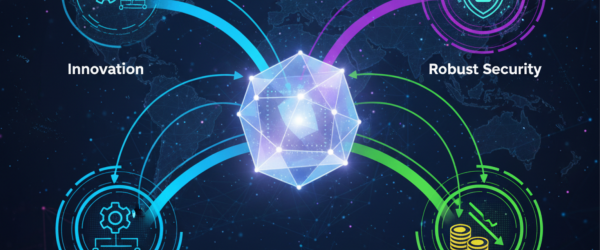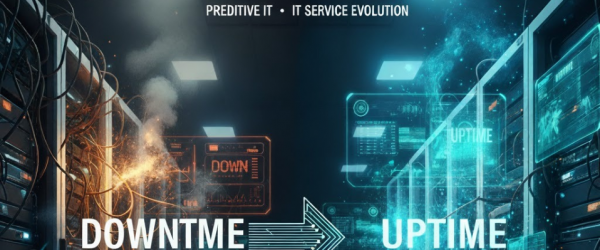Introduction
In an era of constant market shifts and digital disruption, “business agility” has moved from a buzzword to a non-negotiable survival trait. But true agility isn’t just about having a nimble team; it’s about having a technology foundation that can pivot just as fast. Many companies, however, are trying to win a modern race with a fragmented tech stack—a collection of disconnected tools that create data silos, slow down processes, and stifle innovation.
This is where the concept of the Digital Core comes in. It’s the integrated heart of your business operations, powered by a strategic suite of interconnected IT solutions. This blog will explore how building this cohesive digital core is the most significant step an enterprise can take to achieve genuine, technology-driven business agility.
The Agility Antagonist: The Fragmented Tech Stack
Before we build the solution, we must understand the problem. The average enterprise uses 364 different SaaS applications. While each tool may serve a departmental need, the lack of integration creates critical bottlenecks:
- Data Silos: Customer data in your CRM doesn’t talk to the support data in your helpdesk software, leading to a fragmented customer view.
- Manual Workflows: Employees waste time manually transferring data between systems, a process that is both slow and prone to error.
- Inconsistent Reporting: Leaders struggle to get a single source of truth, making data-driven decision-making a laborious, unreliable process.
A study by MuleSoft found that “89% of IT leaders say data silos are an ongoing problem for their organization,” hindering their ability to deliver seamless customer experiences.
The Integrated Solution: What is a “Digital Core”?
A Digital Core is not a single software package. It is a strategic architecture where your core business systems—ERP, CRM, HRM, SCM—are seamlessly connected, sharing data in real-time through APIs and middleware. It acts as the central nervous system for your entire organization.
Key Components of an Integrated Digital Core:
- Cloud-Based Platforms: The foundation, offering scalability and accessibility.
- APIs (Application Programming Interfaces): The connectors that allow different applications to communicate.
- Centralized Data Lake/Warehouse: A single repository for all business data, enabling unified analytics.
- Workflow Automation Tools: The logic that automates processes across different systems.
How an Integrated Digital Core Fuels Business Agility
The transition from fragmentation to integration delivers tangible agility benefits across the organization.
1. Accelerated Decision-Making
With a unified data platform, decision-makers have access to real-time, cross-functional insights. Instead of waiting days for a consolidated report from multiple departments, leaders can view interactive dashboards that show the interplay between sales, inventory, and marketing campaigns instantly.
2. Streamlined and Automated Operations
Integration enables end-to-end process automation. For example, when a sales opportunity is marked “Closed-Won” in the CRM, it can automatically trigger a series of events: creating a customer record in the billing system, provisioning services, and scheduling an onboarding email—all without human intervention.
3. Enhanced Customer Responsiveness
A 360-degree customer view, built by integrating data from sales, support, and marketing, allows you to personalize interactions and resolve issues faster. This directly translates to increased customer satisfaction and loyalty.
4. Improved Innovation and Scalability
When your foundational systems are stable, connected, and automated, your IT team can shift its focus from maintenance and fire-fighting to strategic innovation. Furthermore, a cloud-based, integrated core can easily scale up or down based on demand, supporting business growth without incurring massive capital expenditures.
Fragmented vs. Integrated: A Comparative Impact
| Business Function | Fragmented Systems (Silos) | Integrated Digital Core |
|---|---|---|
| Data & Reporting | Inconsistent, manual, delayed reports. | A single source of truth with real-time analytics. |
| Customer Service | Agents lack full context, leading to longer resolution times. | Complete customer history enables personalized, swift support. |
| Operational Efficiency | Manual data entry and cross-system workflows create bottlenecks. | Automated, end-to-end processes accelerate operations. |
| IT Resource Allocation | 70-80% on maintenance and integration “patches.” | Focus on innovation, security, and strategic projects. |
| Scalability | Difficult and expensive; requires integrating each new tool. | Built-in scalability through cloud and API-first architecture. |
Building Your Agile Digital Core: A Strategic Approach
Building a digital core is a journey, not a one-time project. A successful strategy involves:
- Audit and Map: Catalog all existing applications and map critical data flows and process dependencies.
- Define the Architecture: Choose a flexible, API-driven architecture (e.g., microservices) that prevents future silos.
- Prioritize by Value: Start with high-impact, high-pain-point integrations, such as connecting CRM and ERP for a unified lead-to-cash process.
- Foster a Collaborative Culture: Ensure business and IT leaders work together to define requirements and outcomes.
Conclusion: Agility as a Structural Outcome
In the digital age, agility is not a matter of chance but of architecture. A business cannot be truly agile if its technological heart is weak and disconnected. By investing in integrated IT solutions to build a robust digital core, enterprises do more than just streamline operations—they build a foundational capability to adapt, innovate, and lead in their markets.
The question is no longer if you should integrate, but how soon you can begin the journey to build the resilient, responsive, and agile business the future demands.







